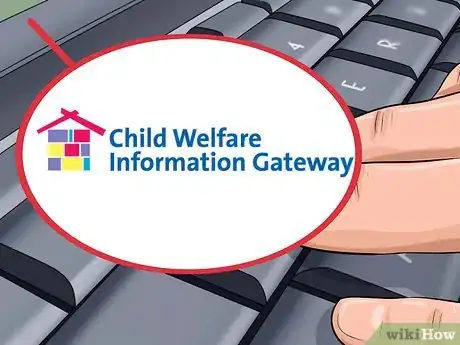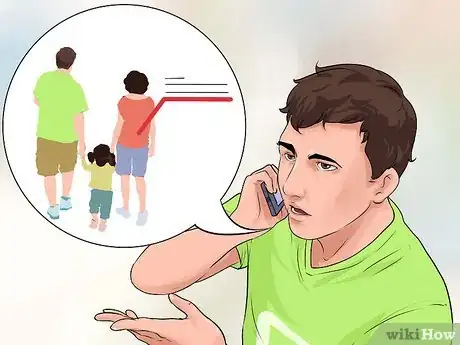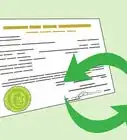This article was co-authored by Clinton M. Sandvick, JD, PhD. Clinton M. Sandvick worked as a civil litigator in California for over 7 years. He received his JD from the University of Wisconsin-Madison in 1998 and his PhD in American History from the University of Oregon in 2013.
There are 11 references cited in this article, which can be found at the bottom of the page.
This article has been viewed 270,778 times.
Making an adoption plan for your child can be the ultimate act of love. If you are unable to meet the legal and moral responsibilities of parenthood, there are professional adoption services and agencies to help you find a loving forever home for your baby.
Steps
Preparing for the Adoption
-
1Know your rights. As the birth parent of a child, you have a set of legal and moral rights. The courts have repeatedly held that it is a fundamental liberty to raise your child as you wish. You have the right to a relationship with your child and to direct her educational, moral, and religious upbringing.
- You have a reciprocal responsibility to provide the financial and material support your child needs to be housed, clothed, and fed. As the parent, you also have a moral responsibility to provide a safe and nurturing environment for your child.[1]
- You may need to research the law in your particular country. In the adoption process, the country you live in will determine what laws your situation falls under. The laws in England may be very different than in Kenya.
-
2Consider your options in your country. Knowing your rights and responsibilities, an unplanned pregnancy or inability to care for a child is a stressful and emotional time.[2] Before you make a decision, you should examine and consider your options. Adoption should be approached as a permanent decision and that you are doing what is best for you and your child. Below is a list of common adoption situations, but you need to determine what options are available in your locale.
- Guardianship can be a temporary solution while you establish the emotional and financial resources you need to be a parent. The court awards temporary custody to a family member or other agreed party. You retain your parental rights and contribute to the child's financial support while the guardian handles the day-to-day job of child-raising. The guardianship can be dissolved by the court when you are fit and ready to be a parent.[3]
- Kinship adoption can be a permanent solution that keeps your child in the family and lets you maintain a relationship with her. Instead of a stranger, your child is adopted by the grandparents or other close relative. This type of voluntary in-family adoption can be handled by a private attorney in a very short time. Procedures, including home studies, are often less stringent or waived.
- Open adoptions allow the birth parents to interact with the child and adoptive family. In an open adoption, even though you surrender your legal rights, you can play a bigger part in choosing the adoptive family and express your wishes on how the child will be raised. An open adoption also lets your family have limited participation through letters, gifts, and even visits. The adoptive family must consent to an open adoption.[4]
- Traditional or closed adoption. In the traditional adoption, the birth parents have little to no input or contact with the adoptive family and the records are sealed. This type of adoption offers the most privacy and can give the birth parents a sense of closure and the ability to move on after making the difficult decision.[5]
Advertisement -
3Make your decision. Unless the court is involved, the choice to give your baby or older child up for adoption is ultimately yours. You need to think clearly and not allow others to pressure you into a decision.
- Consider speaking to a counselor to talk about your emotions surrounding the decision. Depending on your circumstances, you may want to continue with therapy after you make your choice.
- Speak with other birth mothers to understand what a birth mother may experience post-placement. This will help you relax and find peace with your decision.
- If you have any questions or doubts about your parental rights and responsibilities, you should have a discussion with a family law attorney.
- In a court case where your child may be in foster care, you have the right to legal counsel. You can discuss the possibility of adoption with your lawyer.
- The process will go smoother and faster if the other parent consents. If it is practical and safe, you should discuss your decision with the other birth parent.
Planning the Adoption
-
1Research adoption agencies. After the decision to adopt, choosing an agency is the next most important choice you will make. Like having a good lawyer or other professional in your corner, a qualified adoption agency can lessen the stress of a difficult situation. Adoption agencies vet adoptive families and match them with birth mothers and children. They handle the home studies and other legal requirements and act as the go-between with adoption attorneys and the court system. In some cases, they even arrange foster care for infants abandoned by the birth parents.
- State law regulates adoption agencies. In order to be licensed, the agency must meet stringent requirements. The state will look at staff, training, programs, facilities, and insurance.[6]
- Professional associations, such as the American Academy of Adoption Attorneys, and child welfare organizations maintain directories of licensed adoption agencies.[7]
-
2Evaluate potential adoption agencies. You want an adoption agency that has the skills, contacts, and programs to provide the services needed to match your baby with the best possible home. Doing your research before you enter into an agreement can lessen your stress.
- Check the agency's website. This will give you a snapshot of the agency's operations. The site should include contact information, licensing information, professional accreditation, mission statement information, and information for both birth parents and adoptive parents.[8]
- Do an online search with the name of the agency and "review", "scam", and "complaint." Read the reviews and testimonials carefully. A single complaint may not disqualify an agency, but a large number or similar complaints should be a warning.
- Contact a local parent or adoption support group. You can find groups through online searches, resources at your obstetrician's office, or through a professional organization such as the North American Council on Adoptable Children. Groups can range from public and private forums to groups that hold physical meetings. Find a group that gives you the information you need and meets your level of comfort and privacy.
-
3Contact prospective agencies. Some agencies may offer a phone consultation, others may insist on an in-person appointment or request that you fill out a preliminary application. Write out your questions before you have your appointment and be prepared to take notes.
- Verify licensing. Ask about the agency's licensing and accreditation and that it is current.
- Ask about open and closed adoptions. You want an agency that is in line with your own wishes. Even in a closed adoption, information like family medical history will be available to the adoptive parents. After that, as much or little information can be shared by agreement of the parties.
- If it is important to you that your child be placed with a family of the same race or religion, now is the time to ask about the agency's philosophies on the matter.
- Ask about financial support. No birth mother is allowed to "sell" her baby. However, state laws do provide for some financial support during the pregnancy and assistance with medical expenses. Laws vary with most states being "reasonable and customary" expenses. A few states put a dollar limit ranging from $1,000 to $5,000.[9]
- Ask about references and testimonials. While the agency cannot reveal private information, many parents will have consented to let the agency tell their stories. While the picture will be skewed toward the positive, it can give you an indication of the kind of families the agency works with.
- Ask about your right to revoke consent to the adoption. This can be as difficult a decision as choosing to put your child up for adoption. Most states have a very short window where you have a right to change your mind. Ask the agency if they have a set procedure for revocation. Laws are different in every state.[10]
Arranging the Adoption
-
1Cooperate with the agency. After you have chosen an agency that is right for you and your baby, it is your duty to cooperate with the rules and procedures. Depending on where you are in your pregnancy or if this is an older child, the agency will set up a timeline for the adoption.
- If this is to be an open adoption, you may be allowed to look over profiles of adoptive families and choose those that match your hopes and expectations for your child.
- If you are pregnant, follow through with your medical care and doctor's orders. Act in the best interest of your child.
-
2Give information about the other parent. You will have to give the agency all the information you have about your partner. Do not lie or withhold information. If you say you don't know who the father is or where the other parent is, the court may act accordingly in granting the adoption. However, if the birth parent comes forward and refutes this, the adoption could potentially be cancelled and you could be held in contempt for lying to the court.
- The agency will try to get the other birth parent to consent or serve him or her with notice of the adoption hearing.
- Specifically, if a birth father wants to contest the adoption, he must acknowledge paternity, prove he has (or intended to) have a relationship with the child, and be prepared to provide support. He will have to have his own attorney and your interests will be represented by the agency's attorney. Cooperate and provide any information that is requested.
-
3Give your consent to the adoption. If you are pregnant, you will typically not give consent until the child has been safely delivered. Most states have a waiting period, to give you time to recover from the birth and not be under the influence of pain medication. The waiting period can be as short as 12 hours or up to 15 days. The typical waiting period is 24 to 48 hours. Consent documents will be signed in front of a notary or a judge.[11]
- Even if you have been working with an agency, you have a right to consult with an independent attorney before you sign the consent forms.
- Once you sign the consent forms, the decision is considered permanent unless you revoke during the very limited window or can prove your signature was obtained under fraud or duress.
-
4Finalize the adoption. Once you sign the consent forms, your participation is complete. Stay in touch with the agency to be aware of the adoption timeline and that it was completed without incident. If the adoption is open, you can receive more detailed information about the procedure and finalization.
- The agency should have after-care programs, such as counseling to help you recover for the birth and the surrender of the child. If not, consider seeking independent counseling.
References
- ↑ http://www.parentcoachplan.com/article3.php#.Veur8RFVhBc
- ↑ https://www.childwelfare.gov/topics/adoption/birthfor/emotional-impact/
- ↑ https://www.childwelfare.gov/topics/permanency/guardianship/
- ↑ https://www.childwelfare.gov/pubPDFs/openadoption.pdf
- ↑ http://americanpregnancy.org/adoption/closed-adoption-advantages/
- ↑ http://www.adoptionattorneys.org/aaaa/adopting-parents/agencies-page
- ↑ https://www.childwelfare.gov/nfcad/index.cfm?event=viewSearchForm
- ↑ http://www.adoption-beyond.org/
- ↑ https://www.childwelfare.gov/pubPDFs/expenses.pdf
About This Article
While putting your child up for adoption can be a difficult decision, there are services that can help you find a loving family for them. Before you make a decision, consider some of your options so you can make the best decision for everyone involved. For example, you can set up a guardianship in which the court awards temporary custody to a family member while you establish the emotional and financial resources needed to be a parent. Another option is kinship adoption, which means your child will be permanently adopted by a close relative. Open adoption allows the birth parents to interact with their child and adoptive family, but closed or traditional adoption means you’ll have no input or contact with your child or their adoptive family. Once you decide which option is best, research adoption agencies so you’re sure they offer the services that will best help your child. To learn how to give your consent for the adoption, keep reading!





































































